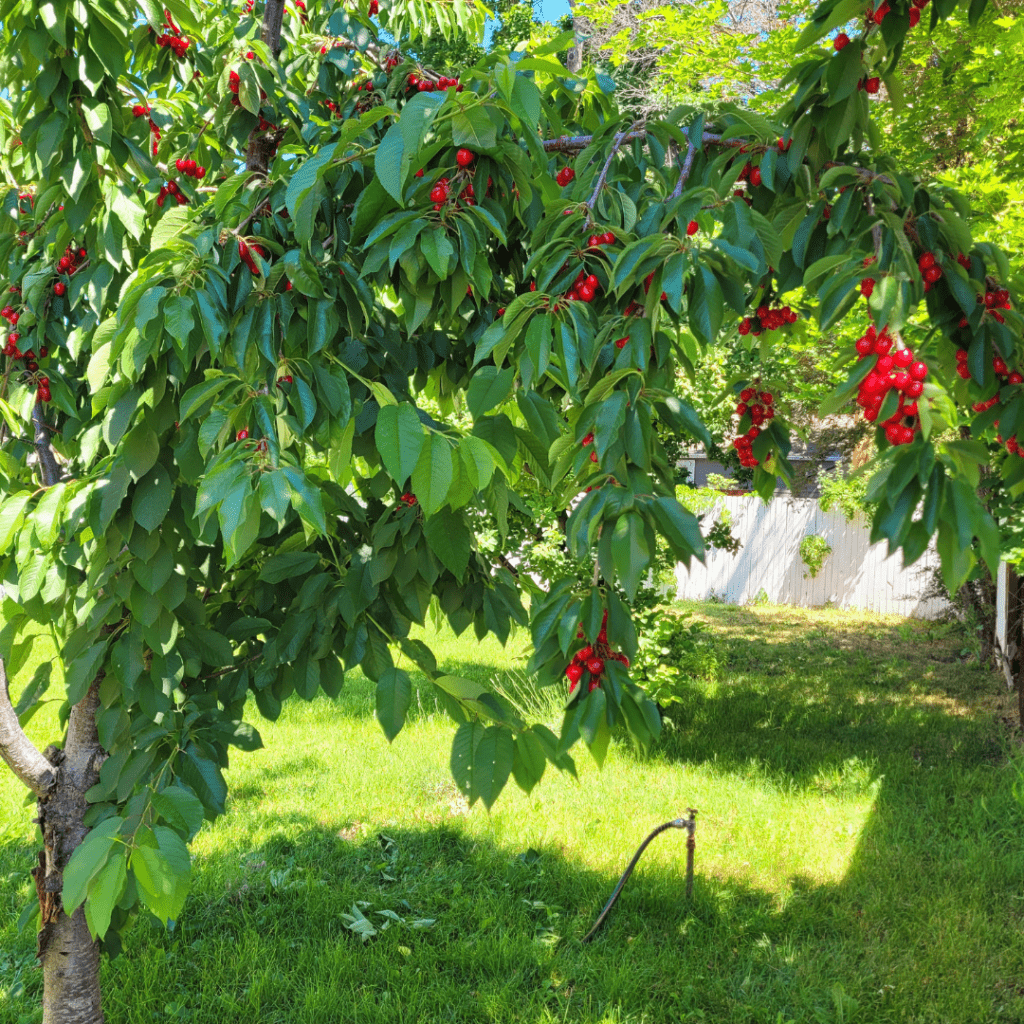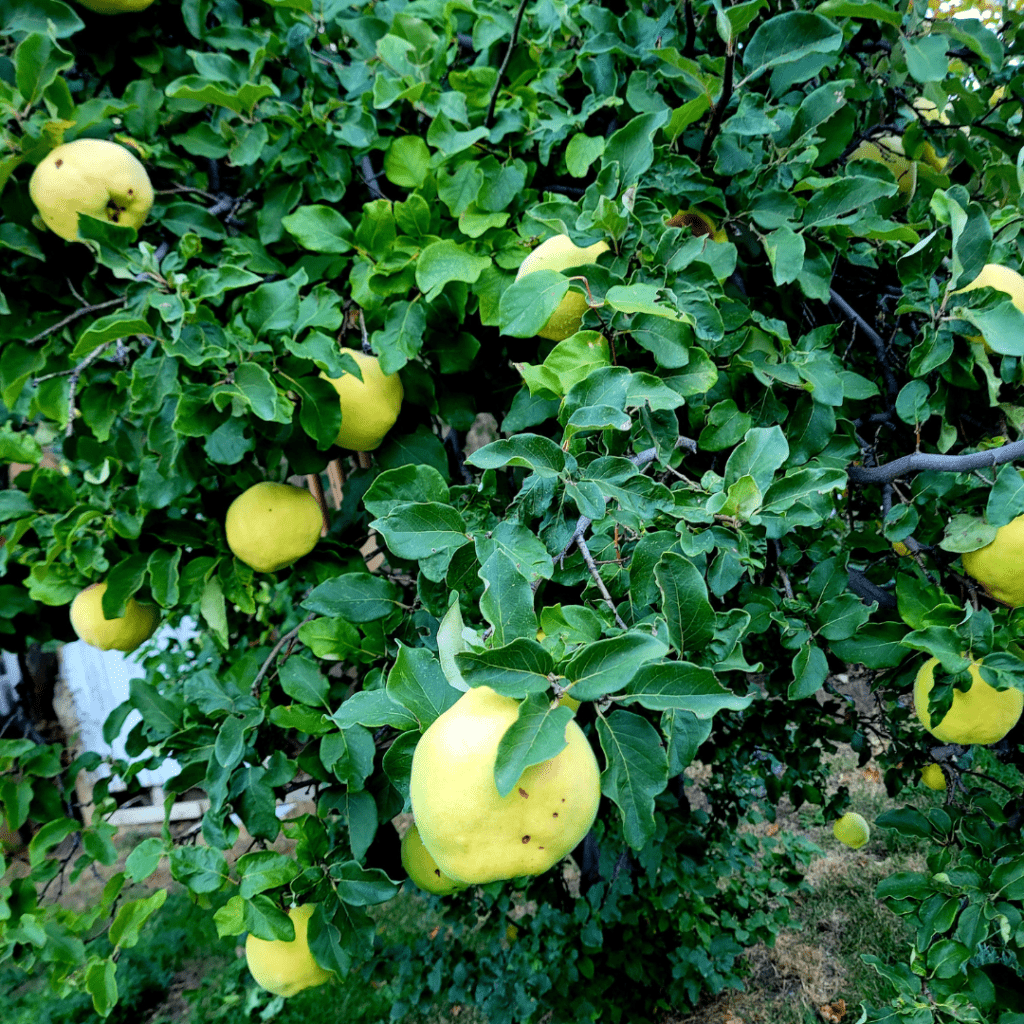Pear trees are a beautiful and productive addition to any backyard garden, offering sweet, juicy fruit and fragrant spring blossoms. In this guide, you’ll learn everything you need to know about growing, caring for, and harvesting pear trees—whether you’re planting your first sapling or managing a mature orchard. Discover the best pear tree varieties, how to prune for maximum yield, and tips for preventing common pests and diseases.
Pear trees, known for their beauty and delectable fruit, have been cherished for centuries. Whether you are a beginner gardener or an experienced orchardist, understanding the intricacies of pear tree cultivation is essential for success.
This ultimate guide dives into the world of pear trees, offering comprehensive insights on various aspects such as pear tree varieties, planting and caring techniques, pruning and training methods, common pests and diseases, harvesting and storage tips, culinary uses, and answers to frequently asked questions.
By the end of this guide, you will have a wealth of knowledge to embark on your pear-growing journey with confidence and cultivate thriving pear trees that bear abundant, luscious fruits.
This is a pinnable post. Tap or hover over any image in this post to pin to your Pinterest Boards.
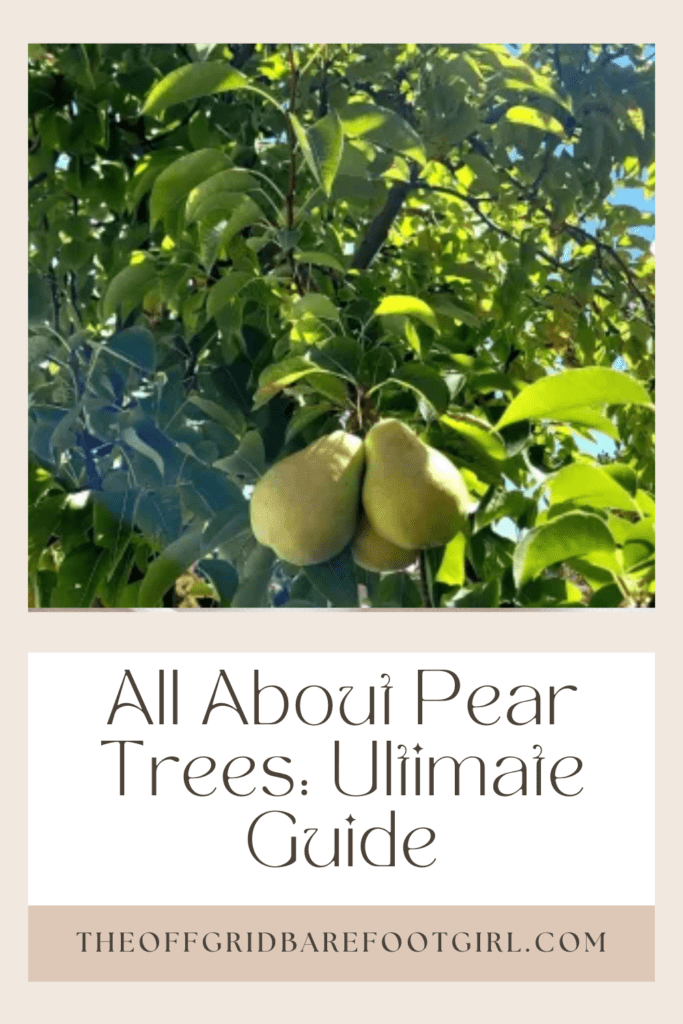
Introduction to Pear Trees
Overview of Pear Trees
Ah, the pear tree. A delightful addition to any garden, the pear tree is known for its luscious fruit and graceful appearance. These trees belong to the Pyrus genus and are part of the Rosaceae family, which also includes roses and apples. With their lovely flowers in spring and abundant fruit in late summer, pear trees bring beauty and deliciousness to your backyard.
Historical Significance of Pear Trees
Pear trees have quite a rich history, my friend. They have been cultivated for thousands of years, with their origins tracing back to China and Europe. In fact, they were a favorite of the ancient Greeks and Romans, who considered pears to be a symbol of immortality.
Talk about high praise for a fruit! Pear trees have symbolized wisdom, longevity, and fertility in various cultures throughout history. So, planting a pear tree is like having a historical icon right in your yard. How cool is that?
My Backyard Pear Tree
I absolutely love my pear tree for so many reasons! First and foremost, the beauty it brings to my backyard is simply breathtaking. The luscious green leaves sway gently in the wind, creating a peaceful and serene ambiance. But it’s not just about its visual appeal; this tree also offers delicious fruit every year. When the pears are ripe, their sweet aroma fills the air, enticing me to pluck them straight from the branches and indulge in their juicy goodness.
Not only do they taste amazing on their own, but they also make for fantastic additions to salads, pies, jams, and more. There’s something truly satisfying about growing your own food right at home. The sense of accomplishment that comes with nurturing this tree through each season is indescribable.
Plus, I can share the bountiful harvest with friends and family, spreading the joy of fresh and organic produce. My pear tree is like a symbol of nature’s generosity and my connection to it – an everyday reminder of how wonderful our world can be when we take care of it.
Pear trees bring delight to the garden from their gorgeous spring blooms to the delicious, bountiful fruit that follows in the fall season. You can be sure to be given a huge harvest from your pear tree,e so be prepared to learn how to preserve them and devour some pear recipes.
The pear tree in my backyard orchard is the pear semi-dwarf Bartlett (Pyrus) variety. It will live to about 25 years and produce an average of 100 to 200 pounds of pears per year.
Springtime Blooms: When Pear Trees Flower and Fruit Begins
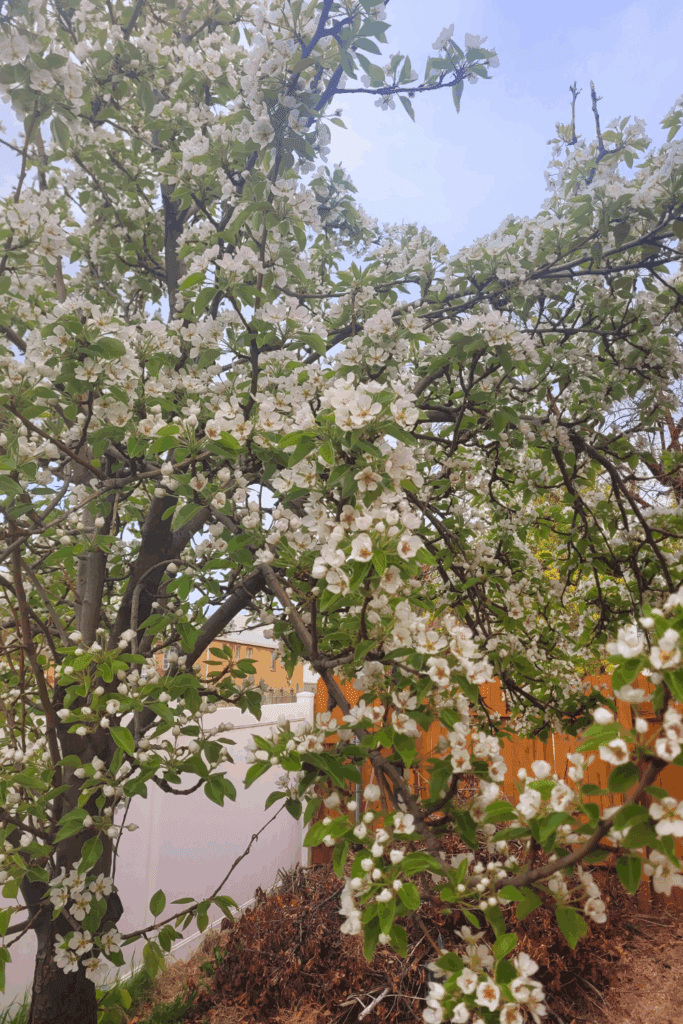
In early to mid-spring, pear trees burst into bloom with delicate white flowers that cover their branches like lace, marking the beginning of fruit production. These fragrant blossoms are not only a beautiful sight but also a critical stage for pollination.
To help your tree set fruit successfully, it’s important to encourage pollinators like bees by avoiding pesticide use during bloom and planting companion flowers nearby.
During this time, I always pause to admire my own pear tree—its graceful blooms signaling that another season of sweet, juicy pears is on the way. It’s one of the most magical sights in my backyard orchard.
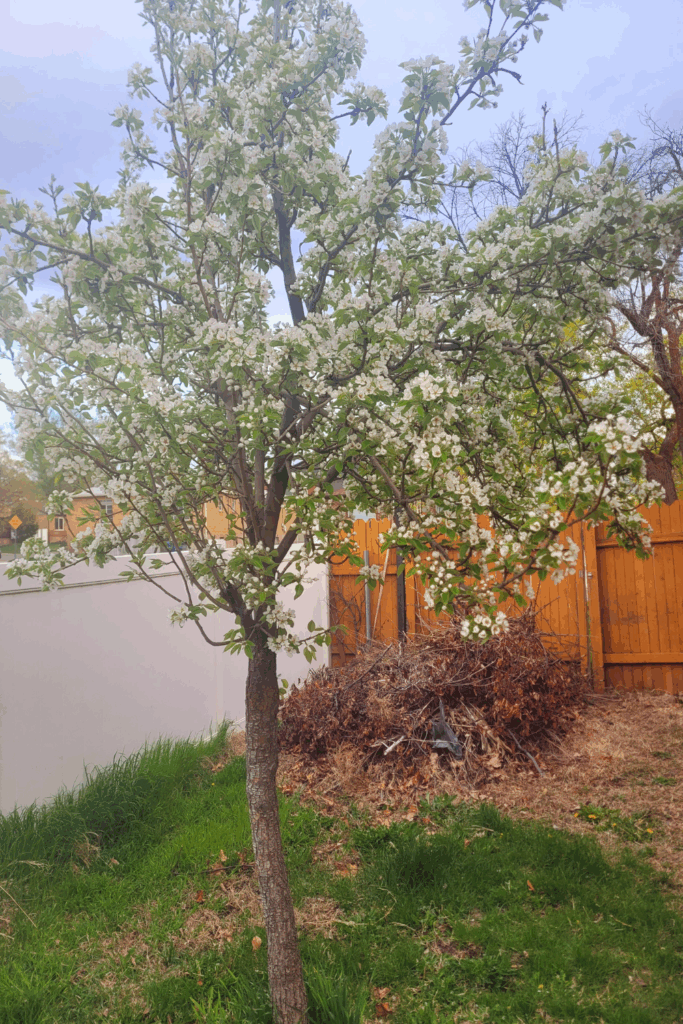
Varieties of Pear Trees
Common Pear Varieties
When it comes to pear varieties, you’ve got some options. Some common pear varieties include the Bartlett, Anjou, Bosc, and Comice.
- The Bartlett pear is a classic favorite, known for its sweet and juicy flesh.
- Anjou pears, on the other hand, are a bit more on the mellow and buttery side, perfect for snacking or baking.
- Bosc pears have a unique, elongated shape and a slightly spicy flavor.
- And if you’re looking for a pear with a buttery texture and a lovely floral aroma, the Comice pear is the one for you.
With these varieties, your taste buds are in for a treat!
Specialty Pear Varieties
If you’re feeling a bit adventurous, you might want to try some specialty pear varieties. These pears have their own distinct characteristics that make them stand out. For a crisp and refreshing bite, the Asian pear is a top choice. With their apple-like texture and sweet flavor, Asian pears bring a delightful crunch to your taste buds.
And if you’re in the mood for a pear with a hint of citrus, the Seckel pear is a winner. It might be small in size, but it packs a punch of flavor. So, go ahead and explore these specialty varieties to add a unique twist to your pear collection.
Year When Pear Trees Bear Fruit
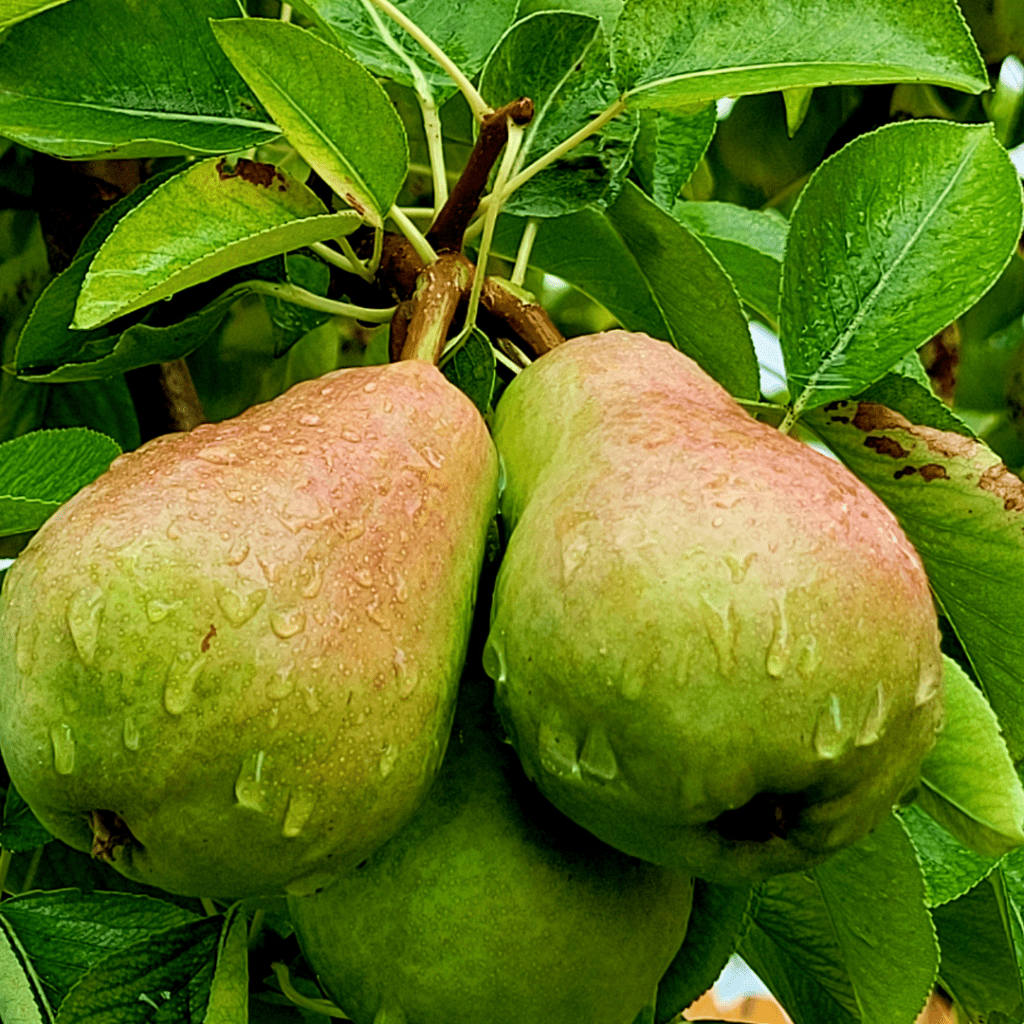
Pear trees begin to bear fruit within three to seven years after planting. If grown and propagated from cuttings, this fruit tree can begin to bear fruit sooner.
Pear trees can last up to 50 years and produce up to 1,250 pounds of fruit per year for a single tree. Pear trees are popular for small space backyard orchards, and they are so delicious.
Planting and Caring for Pear Trees
Selecting the Right Location for Planting
Finding the perfect spot for your pear tree is crucial, my gardening aficionado. These trees crave sunlight, so choose a location that receives at least six hours of direct sunlight each day. Additionally, make sure the soil has good drainage to prevent waterlogged roots, which could lead to unhappy trees. Oh, and watch out for any nearby structures or plants that could shade your pear tree.
Preparing the Soil for Pear Trees
Before you get digging, let’s talk soil preparation. Pear trees prefer well-drained soil with a slightly acidic to neutral pH. To give your tree the best start, enrich the soil with organic matter like compost or well-rotted manure. This will provide vital nutrients and improve the soil structure. Remember, happy roots make for happy trees!
Planting Techniques for Pear Trees
Now it’s time to get your hands dirty, my green-thumbed friend. When planting a pear tree, dig a hole that is wide and deep enough to accommodate the tree’s root system. Gently loosen the roots before placing the tree in the hole, making sure it sits at the same depth as it was in the nursery.
Backfill the hole with soil, firming it gently around the roots. Finally, give your tree a good drink of water, and voila! You’ve officially planted a pear tree.
Watering and Fertilizing Pear Trees
Pear trees appreciate a good watering routine, but don’t overdo it. Aim to water deeply once a week, providing enough moisture to reach the roots. During hot and dry spells, increase the frequency to keep those roots happy.
As for fertilizing, pear trees generally benefit from an annual dose of balanced fertilizer in the early spring. Just remember, moderation is key! Too much fertilizer can lead to excessive growth without much fruit to show for it.
What Pears Look Like in the Early Stages of Growth
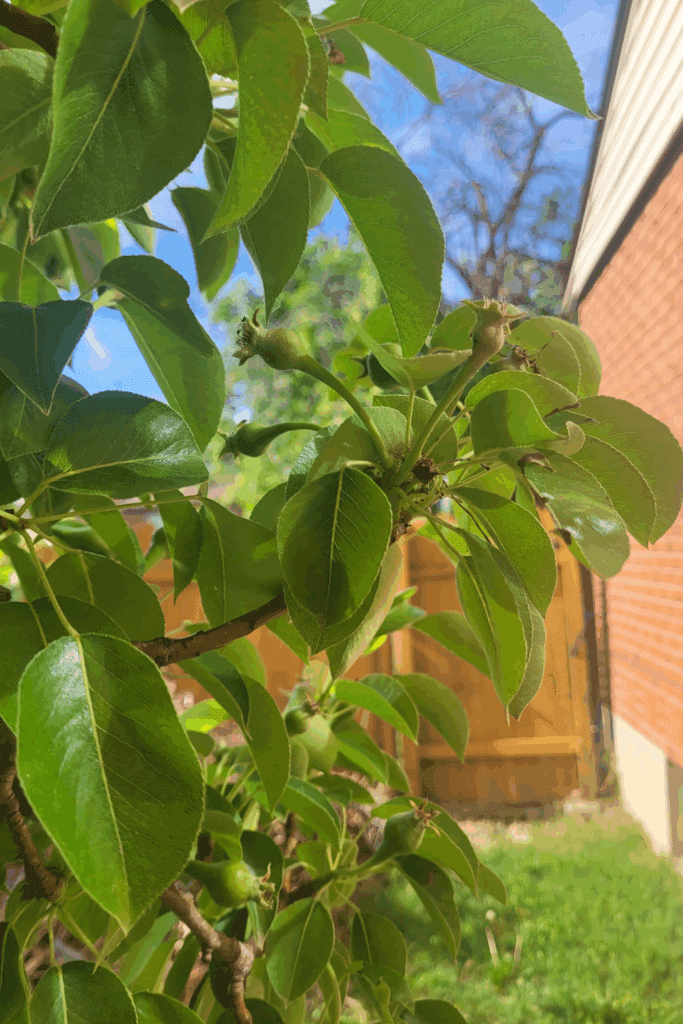
When pears begin to grow, they start as tiny, green, oval-shaped buds that form shortly after the blossoms fall off the tree. These baby pears are usually about the size of a pea or marble, with a smooth, firm surface and a slight sheen. At this stage, they may still have remnants of the flower attached to their ends, giving them a slightly fuzzy or frilled tip.
As they develop, they begin to take on the familiar pear shape—narrow at the top and fuller toward the base—but remain small and hard to the touch. The color is typically a pale green, blending in with the surrounding leaves, and they gradually enlarge over the following weeks as they mature on the branch.
Harvesting and Storing Pears
So, you’ve nurtured your pear tree, and now it’s time to reap the rewards! Let’s talk about the ins and outs of harvesting and storing those delicious pears.
Determining the Right Time to Harvest Pears
When it comes to pear picking, timing is everything. To check if your pears are ready, gently tilt them upward. If the stem snaps off easily, congratulations, you’ve got ripe fruit! On the other hand, if it’s still tightly attached, give it some more time.
Keep in mind that pears don’t ripen well on the tree, so it’s best to harvest them slightly underripe. They’ll continue to ripen off the tree, giving you that perfect balance of sweet and juicy.
Proper Techniques for Harvesting Pears
Now that you know when to harvest, let’s discuss how to do it without causing a pear-mageddon. Hold the fruit in one hand and give it a gentle twist. If it comes off easily, great!
If not, keep the pear on the tree a little longer. Make sure to leave a short stem! Leaving a short stem on the pears will help prolong freshness. If the stem is ripped off, the pear will have a wound and it will turn bad quickly.
Handle pears with care to prevent bruising and store them in a shallow container to avoid excessive pressure on the fruit.
Storage and Preservation Tips for Pears
To keep your pears at their best, store them in a cool, dark place with good ventilation. This will slow down the ripening process and extend their shelf life.
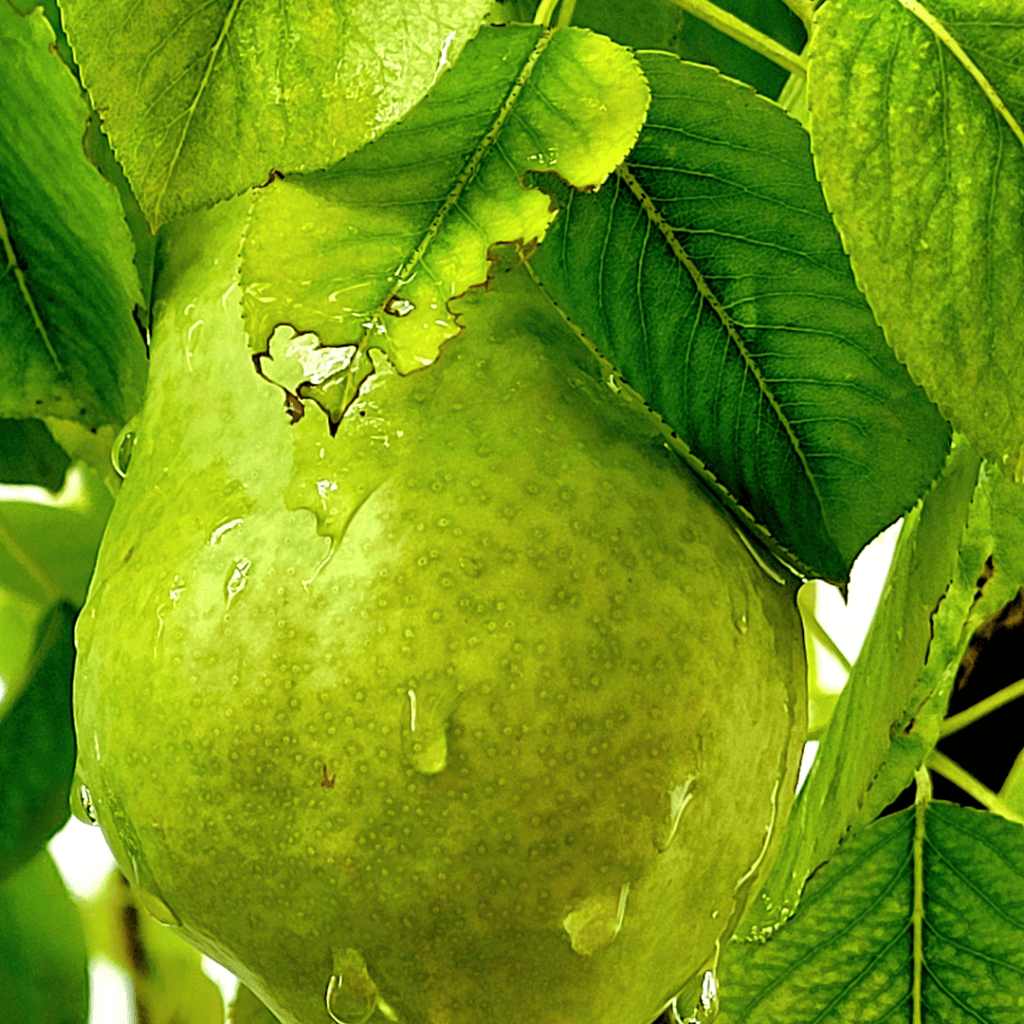
If you want to enjoy your pears for an extended period, consider preserving them. You can make pear jam, and pear butter, or even can them for future use. Get creative in the kitchen and savor the flavors of your harvest all year round!
Your pear tree will begin to produce a massive amount of pears and you will need to learn how to can them.
Culinary Uses of Pears
Pears are not only delightful to eat fresh, but they also shine in various culinary creations. Let’s explore some mouthwatering pear-based recipes and how to preserve pears for future culinary adventures.
Delicious Pear-Based Recipes
Get ready to tantalize your taste buds with these pear-licious recipes. How about a pear and Gorgonzola salad with a tangy vinaigrette? Or maybe try your hand at a classic French dessert like pear tarte Tatin. And let’s not forget about the heavenly combination of pears and chocolate in a decadent tart. The possibilities are endless!
Preserving Pears for Culinary Use
If you find yourself with an abundance of pears, don’t let them go to waste. Preserve them for future culinary endeavors! You can make canned pears, pear sauce, or even freeze them to use in smoothies or baked goods. So go ahead, get creative, and let your inner chef pear-fectionist shine!
My Pear-fect Recipes!
- The Ultimate Guide to Canning Apple Pear Butter: Step-by-Step Instructions
- Canning Pear Sauce: An Easy Step-by-Step Guide
- How to Make Irresistible Streusel Pear Bread
Pruning and Training Pear Trees
Benefits of Pruning Pear Trees
Ah, the art of pruning! Pruning your pear trees is essential for maintaining their health and productivity. Regular pruning promotes better air circulation, sunlight penetration, and fruit production.
It also helps shape the tree and removes any dead or diseased branches. Plus, it gives you a chance to show off your pruning skills and make your neighbors say, “Wow, they really know how to handle a pair of pruning shears!”
Pruning Techniques for Pear Trees
When it comes to pruning pear trees, it’s important to know the basics. Start by removing any dead, damaged, or weak branches. Then, thin out crowded areas to allow more light and air to reach the inner branches.
Aim to create an open canopy shape, with a scaffold of well-spaced branches. And remember, don’t go overboard, my pruning enthusiast. You don’t want to give your pear tree a drastic haircut that leaves it feeling like it’s never to produce fruit again.
Training Pear Trees on Trellises or Espaliers
For those who like a little creativity in their gardening, training pear trees on trellises or espaliers might be just the ticket. This training technique involves guiding the tree’s branches along a support structure, creating a beautiful, space-saving design.
It not only adds a touch of architectural flair to your garden but also makes it easier to manage and harvest your pears. Just imagine your pear tree showing off its fancy shape and your neighbors going, “Whoa, look at that garden masterpiece!”
Climate for Pear Trees
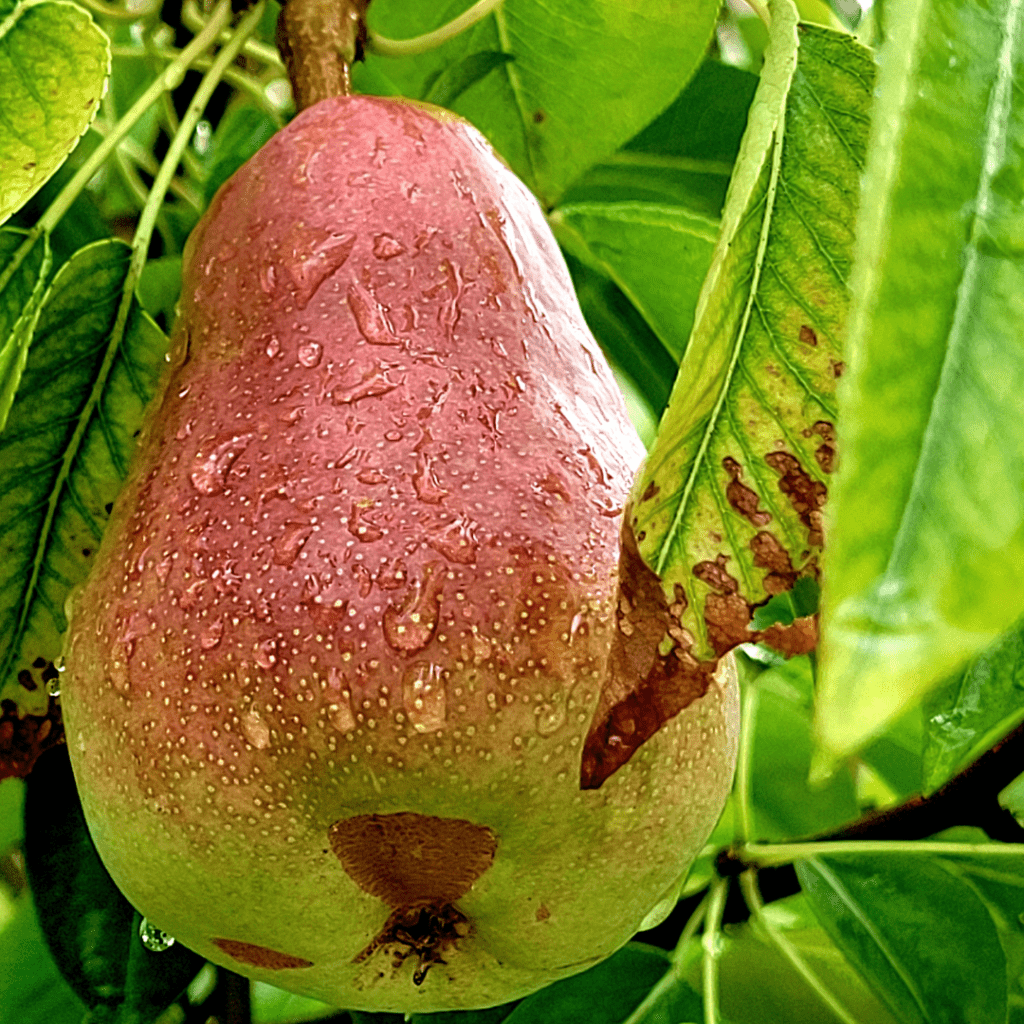
These trees prefer climates where they have a period of cold for them to enter dormancy and a warm, dry climate to grow when they wake up. I live in Northern Utah, where we have long periods of cold winters followed by hot, dry summers, which is the perfect climate for my pear tree.
Growing New Pear Trees From Cuttings
Take cuttings from a mature pear tree in the late fall and early winter seasons when the pear tree has entered its dormancy period, and the cutting is approximately 10 inches long.
Place the cuttings in water to grow the roots, which can take anywhere from a few months to a year to root for planting.
Once the roots are formed, place the rooted cutting in the soil of its permanent home in the garden or container.
Common Pests and Diseases of Pear Trees
Pear trees may be beautiful and tasty, but like any beloved plant, they can fall victim to pests and diseases. Here are some common issues and how to handle them.
Identifying and Treating Common Pests
Pests! Who invited them to the pear party? Unfortunately, they sometimes crash the party uninvited. Look out for aphids, pear psylla, and codling moths. These pesky critters can damage leaves, fruit, and overall tree health.
To tackle aphids, you can use insecticidal soap or a strong burst of water from the hose to knock them off the tree. Pear psylla can be controlled by pruning affected branches or using insecticides early in the season. For those annoying codling moths, you can try wrapping the trunk with a sticky band or using pheromone traps.
Remember to always follow the instructions on any pest control product and be mindful of the impact on beneficial insects.
Prevention and Treatment of Common Diseases
Pear trees can also suffer from diseases like fire blight, pear rust, and powdery mildew. Fire blight, with its bacterial ooze and wilted branches, sounds like an awful party crasher, doesn’t it?
To prevent fire blight, keep your trees properly pruned and ensure good air circulation. If you spot any diseased branches, make sure to remove them promptly and sterilize your pruning tools.
Pear rust shows up as orange-brown spots on the leaves, which is not the autumn look we’re going for. To control it, remove any affected leaves and provide adequate spacing between trees for better air circulation.
Powdery mildew, on the other hand, resembles a light dusting of flour on the leaves. Treat it with fungicides or by removing affected leaves.
Remember, prevention is key. Maintaining good tree health, watering properly, and keeping an eye out for early signs of pests and diseases will help you nip problems in the bud.
Pear Tree Pests and Diseases
- Borer is a thick sap. Worms infest and tunnel through the tree trunks, killing the tree.
- Scale is on the bark of young twigs and branches, weakening the tree that has small, hard, circular, scaly raised bumps with yellow centers, and may also be on fruit.
- Tent caterpillar is a hairy caterpillar that encloses large areas in webbing and feeds on enclosed leaves. Remove them quickly and add them to your burn pile.
- Spider mites are pests that feed off high populations, causing the foliage to appear bronzed on apples and brown to black on pears.
- Black spot disease can cause defoliation and black spots on leaves and thrives in moist conditions. Twigs may also be infected, which can weaken and kill the tree.
- Aphids are the size of a pinhead and vary in color, which sucks the plant juices and weakens and kills the tree.
Conclusion
Remember, when it comes to pear trees, a little knowledge goes a long way in ensuring a fruitful experience!
In conclusion, pear trees are a delightful addition to any garden or orchard, providing both aesthetic beauty and a bountiful harvest of delicious fruit. With the information and techniques shared in this ultimate guide, you are equipped with the knowledge to successfully grow, care for, and enjoy the benefits of pear trees.
Whether you’re a pear tree enthusiast or just starting out, may this guide serve as a valuable resource to help you cultivate healthy, productive pear trees for years to come. Happy pear tree growing!
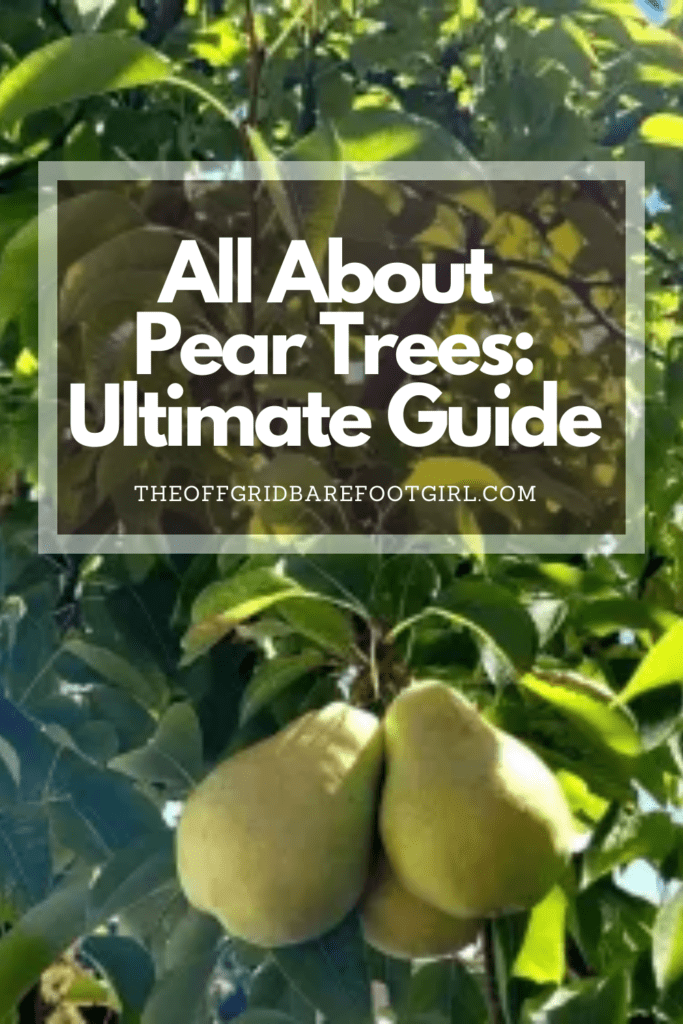
Frequently Asked Questions
1. How much sunlight do pear trees need?
Pear trees love soaking up the sun and ideally require at least 6 hours of direct sunlight each day.
2. Do pear trees need a pollinator?
Most pear tree varieties require cross-pollination with another compatible pear tree for best fruit production. Be sure to check which varieties are compatible before planting.
3. How long does it take for a pear tree to bear fruit?
Patience is a virtue when it comes to pear trees. Depending on the variety, it can take anywhere from 3 to 8 years for a pear tree to start producing fruit.
4. Can I grow a pear tree in a container?
Absolutely! Choose a dwarf or semi-dwarf variety and make sure your container is large enough to accommodate the roots. Just remember to provide proper care and regular fertilization.
5. Can I grow pears from seeds?
While it’s possible to grow a pear tree from seeds, keep in mind that the resulting tree may not produce fruit true to its parent. It’s best to start with a grafted tree for consistent quality and fruit characteristics.
Summary
I hope I have inspired you to grow your own pear tree.
If you were encouraged by this post, I invite you to check out my FREE Printables Page for fun free printables, planners, and charts.
ENTER MY FREE Printables Page HERE
I invite you to check out some more of my posts!
How to Can a Year’s Supply of Quince Jam
All About Cherry Trees: Ultimate Guide
All About Quince Trees: Ultimate Guide
How to Grow a Productive Perennial Raspberry Patch
Why You Need to Start Micro-Orcharding in Your Backyard
How to Grow a Productive Perennial Strawberry Patch
Blessings,
The Off Grid Barefoot Girl



